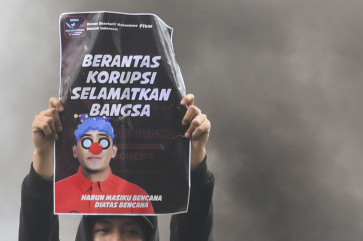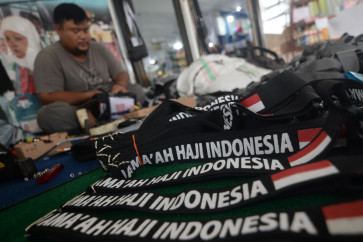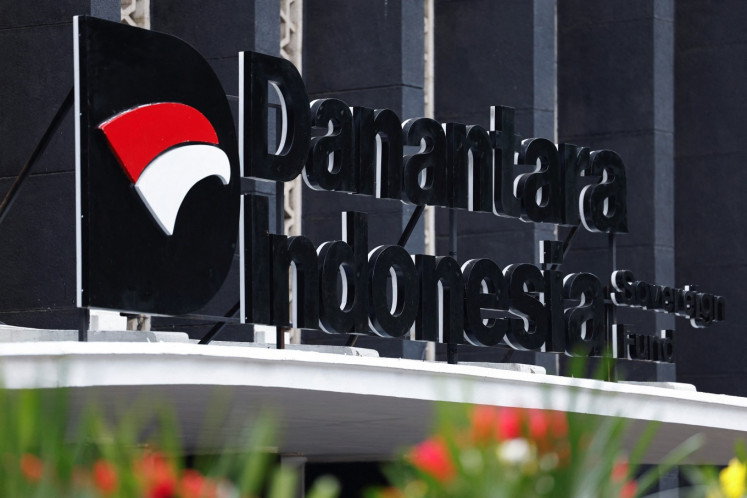Batik Day brings more people to batik learning center
Cultural study: Visitors dye cloth during a workshop at Rumah Batik Palbatu in Menteng Dalam, South Jakarta, on Friday
Change text size
Gift Premium Articles
to Anyone
 Cultural study: Visitors dye cloth during a workshop at Rumah Batik Palbatu in Menteng Dalam, South Jakarta, on Friday. The event was held on National Batik Day, which is marked every year on Oct. 2.(JP/Seto Wardhana) (JP/Seto Wardhana)
Cultural study: Visitors dye cloth during a workshop at Rumah Batik Palbatu in Menteng Dalam, South Jakarta, on Friday. The event was held on National Batik Day, which is marked every year on Oct. 2.(JP/Seto Wardhana) (JP/Seto Wardhana)
Cultural study: Visitors dye cloth during a workshop at Rumah Batik Palbatu in Menteng Dalam, South Jakarta, on Friday. The event was held on National Batik Day, which is marked every year on Oct. 2.(JP/Seto Wardhana)
Dozens of visitors drew designs on fabric to experience making batik at a batik center Jakarta on Friday.
'As we are celebrating Batik Day, the number of visitors has so far today significantly increased to 150 from only around six on normal days,' co-founder of learning center Rumah Batik Palbatu Budi Dwi 'Harry' Haryanto told The Jakarta Post.
Indonesia started celebrating Oct. 2 as Batik Day in 2009 after the United Nations Educational, Scientific and Cultural Organization (UNESCO) designated Indonesian batik as a Masterpiece of Oral and Intangible Heritage of Humanity in the same year.
Harry added that the center had increased promotional activities for the Batik Day commemoration on social media and through their networks, such as universities whose students were regulars at the center.
To attract more visitors, Batik House Palbatu offered all its courses for free on Batik Day. The classes normally cost from Rp 75,000 (US$5.11) to Rp 200,000 depending on the complexity of the batik design.
'We want to use this day [Batik Day] to introduce batik to people,' Harry said.
Although the learning center, which has existed since 2011, has made efforts to promote batik and the government has dedicated Oct. 2 as Batik Day, people's enthusiasm to learn how to make batik does not seem to have extended beyond the national day.
Fauzan Ghozali, 23, a student at Syarif Hidayatullah State Islamic University Jakarta, who was at the learning center on Friday, said he visited because it was Batik Day and he was interested because a friend had invited him.
'I was invited by a friend,' he said, adding that he had not visited the place before. 'My friend got the information from social media.'
Although it was his first time at the learning center, Fauzan hoped the free batik making program would be offered in the future to help in introducing the Indonesian traditional technique of wax dyeing to the wider public.
'I just know from my visit today that making batik is very complicated. It is handmade and the designs are drawn slowly. Now I understand why the prices are so high,' he said with a chuckle.
A piece of handmade batik cloth can reach more than Rp 1 million.
Another visitor, Desy Ratnasary, 23, a teacher, also said that she visited the place because of the national day. 'Only because today is Batik Day.'
Budi Dharmawan, another founder of the learning center, acknowledged that it was hard to promote batik to society not just because people were uninterested in learning batik making but also because it was not supported by the government.
'As far as I know, there has not been any assistance from the government. We do not expect any capital help. Just support us, for example with cloth and fabric for learners,' he said.
'UNESCO has also acknowledged that batik is part of Indonesian cultural heritage. How can we conserve this? The only way is you need to make batik often. Therefore, we want to invite people to learn batik making so they can understand the process,' he said.
Budi said the center was facing some challenges in promoting batik making, including opposition from local residents who believed the process produced waste.
'It does not produce waste,' he said, adding that the most important thing was to educate residents on the importance of preserving cultural heritage. (saf)









